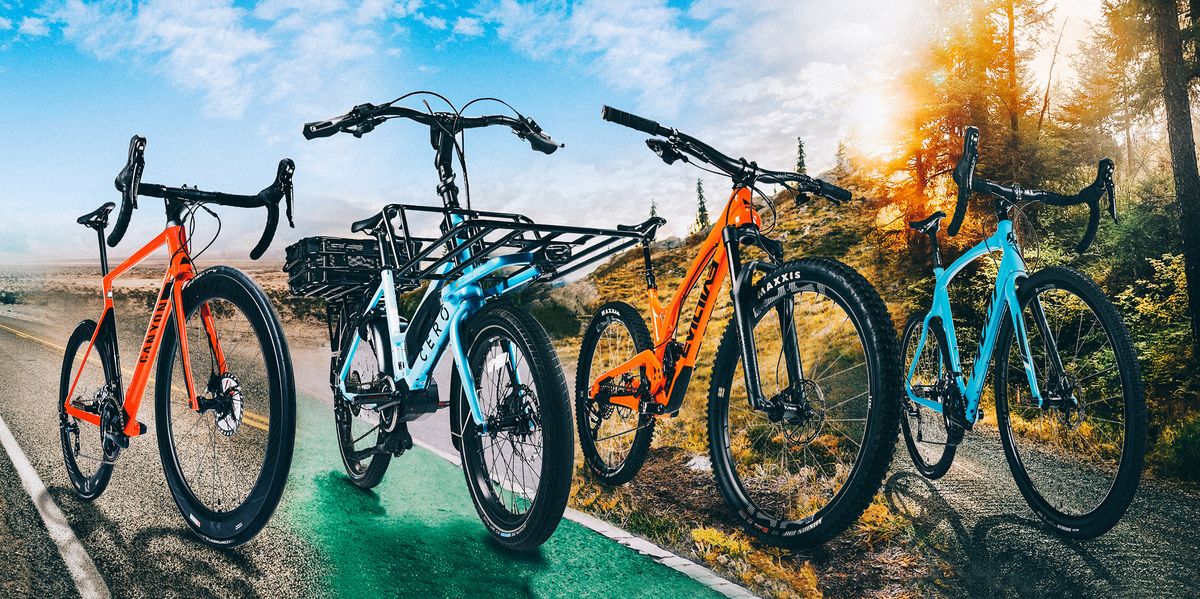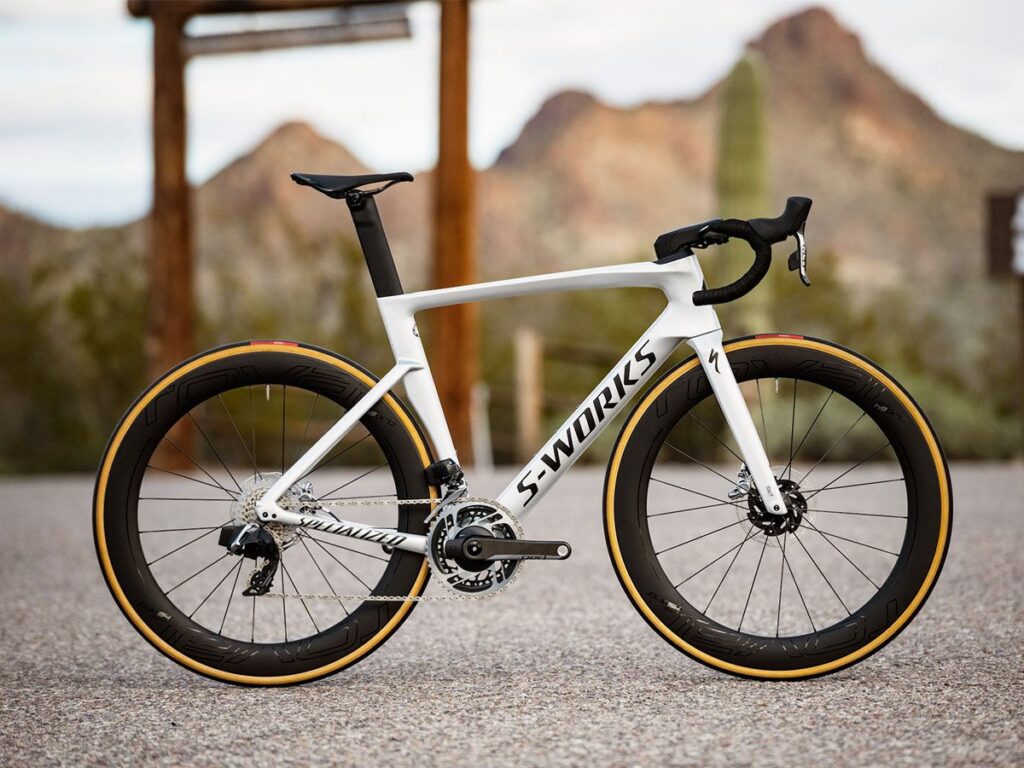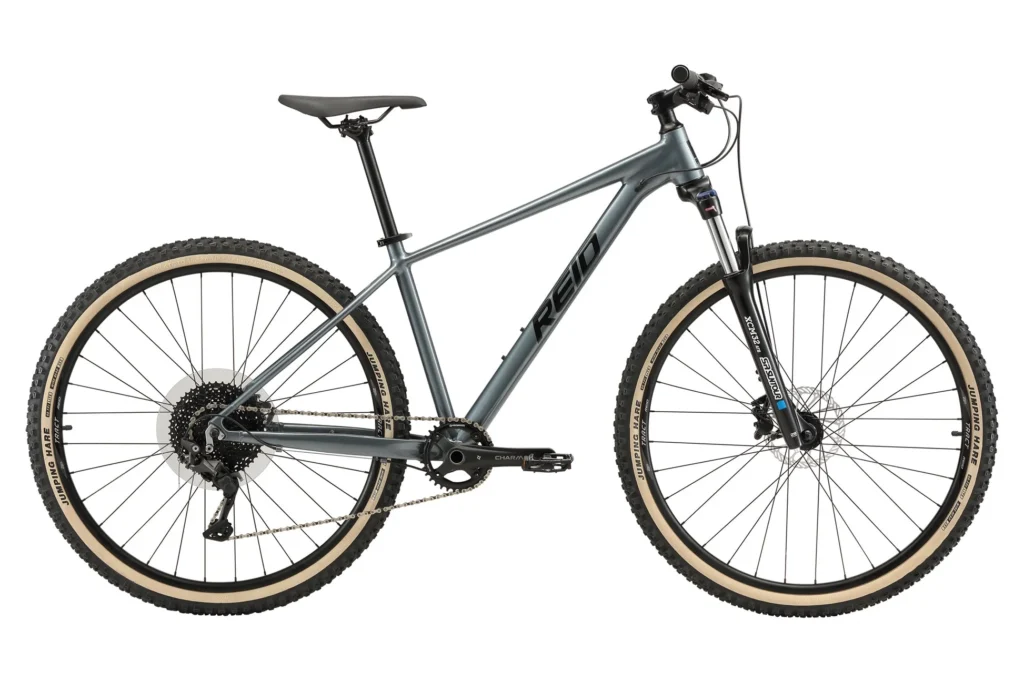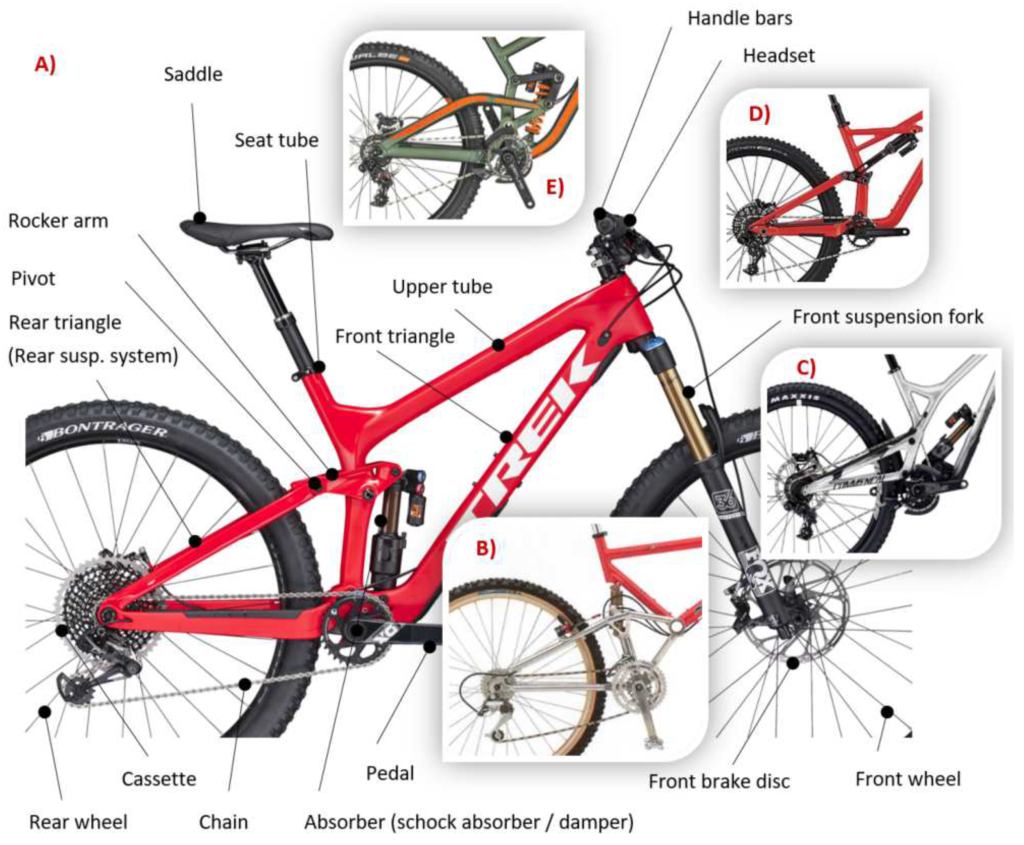


Ever wondered “Why are mountain bikes heavier than road bikes?” Different adventures dictate their weight. Picture this: road bikes love smooth roads, while mountain bikes crave bumpy trails and rocky paths.
The weight difference comes down to their designs. Road bikes are light for speed on smooth surfaces, like a sports car. They are specially designed for city riding or road cycling.
Mountain bikes or gravel bikes, on the other hand, are like sturdy off-road trucks, ready to handle rough terrains.
Let’s explore why this weight gap exists and how it affects the bikes’ performance.
Comparison table between a mountain bike and a road bike:
| Aspect | Mountain Bike | Road Bike |
| Terrain | Off-road, rugged, uneven surfaces | Paved roads, smooth surfaces |
| Frame Construction | Sturdy materials like aluminum or steel | Lightweight materials like carbon fiber |
| Suspension systems | Front and/or rear suspension systems | No suspension systems |
| Tire Size | Wider and more robust tires | Narrower tires for reduced rolling resistance |
| Wheel Components | Reinforced rims and spokes | Lighter weight components |
| Handlebars | Flat or riser handlebars for better control on trails | Drop handlebars for aerodynamics and multiple hand positions |
| Gearing | Wide range of gears for various terrains | Higher gear ratios for increased speed |
| Riding Position | Upright position for better visibility | Forward-leaning position for improved aerodynamics |
| Braking System | Disc brakes or a combination of disc and rim brakes | Rim brakes or disc brakes for better stopping power |
| Weight | Heavier due to sturdy construction and added components | Lighter for increased speed and efficiency |
| Purpose | Off-road adventures, trail riding, and tackling challenging terrain | Speed, endurance, and efficient road riding |
Adventure Designs: Exploring Bikes for Different Thrills



Have you ever noticed that bikes come in various shapes and sizes? They are designed for different adventures! Let’s take a closer look at what we mean by “Adventure Designs.”
Road Bikes: Built for Speed on Smooth Paths
Imagine a sleek road bike as your speedy friend, always ready for a smooth ride on paved roads. These bikes are like race cars, designed to zoom quickly and efficiently. Their adventure involves cruising through city streets or countryside roads, where the path is smooth and predictable.
Mountain Bikes: Tough and Ready for Off-Road Excitement
Now, picture a robust mountain bike as your off-road adventurer, like a trusty off-road vehicle. Mountain bikes are designed to handle the challenges of bumpy trails, rocky paths, paved surfaces, and even muddy terrains. Their adventure is all about exploring the great cross-country sides where the road may not be as friendly.
Hybrid Bikes: Blending the Best of Both Worlds
Some bikes don’t like to be tied down to just roads or mountains. They’re the versatile hybrids! These bikes borrow cool features from both road and mountain bikes, making them great for a mix of adventures. Whether it’s a smooth street or a gravel trail, hybrid bikes are up for it.
City Bikes: Navigating Urban Adventures
City bikes are like the urban explorers of the bike world. They are made for relaxed rides in the city, often with things like fenders, a comfy seat, and a simple design. These bikes are perfect for commuting to school or work or just enjoying a leisurely ride around town.
In a nutshell, “Adventure Designs” simply means that bikes are tailored for specific types of adventures. Whether you’re in the city, on a mountain, or exploring various terrains, there’s a bike designed just for your adventure!
Read More : ” Can Bike Riding Cause Prostate Problems? “
Speedy Road Bikes



Have you ever seen those super-sleek bikes zooming down the road, effortlessly cutting through the air? Those are the speed demons we call “Speedy Road Bikes.” Let’s take a joy ride into the world of these swift machines!
Slim and Trim: The Design Magic
Imagine a bike designed like a streamlined arrow, not too heavy, and built for speed. That’s a road bike! Its frame is sleek and lightweight, allowing it to glide through the air with minimal resistance.
It’s like the Ferrari of the biking world. They are built for extreme road riding.
Thin Tires: Racing on Rails
Road bikes have these super skinny tires that might look a bit different from the chunkier ones you see on other bikes. These thin tires reduce friction on the road, making it easier to go faster or at high speed. It’s like the bike is on rails, smoothly rolling along.
Bent Over and Aero: The Rider’s Pose
Have you noticed how riders on road bikes lean forward while cycling? That’s not just for style—it’s called an aerodynamic riding position. Bending forward helps the rider cut through the wind, allowing them to pedal faster without feeling like they’re biking against a strong breeze.
Gearing Up for Speed: High Gear Fun
Road bikes often have lots of gears. Gears are like the bike’s secret weapons. Riders can switch between them to make pedaling easier uphill or gain more speed on flat roads. It’s like having a turbo boost button for your bike!
Smooth Roads Only: Where Road Bikes Thrive
Road bikes love smooth surfaces. They’re not fans of bumpy trails or off-road adventures. These bikes are happiest when they can cruise on well-paved roads. So, if you’re planning a city ride or a countryside journey on smooth paths, a road bike is your perfect companion.
In a nutshell, “Speedy Road Bikes” are the Formula 1 cars of the biking world. They’re built for pure speed on smooth roads, with a design that makes every ride feel like a thrilling race. If you’re a fan of zipping through the streets with the wind in your hair, a speedy road bike might be your dream ride!
Read More : ” How Many Gears Does A Mountain Bike Have? “
Rugged Mountain Bikes



Have you ever looked at a bike and thought, “This bike looks like it can take on anything!”? Well, that’s the spirit of “Rugged Mountain Bikes.” Buckle up as we dive into the exciting details of these tough and adventurous bicycles!
Built Tough: The Sturdy Frame
Picture a bike with a strong and muscular frame – that’s a rugged mountain bike for you! Unlike the sleek frames of road bikes, these bikes have a robust build designed to handle the challenges of off-road adventures. Rocks, roots, and bumpy trails are no match for their sturdy construction.
Chunky Tires: Grip and Power
Look at the tires on a mountain bike – they’re like the all-terrain superheroes of the biking world. Big, chunky, and full of grip! These tires are built to tackle various surfaces, from dirt paths to rocky trails. They provide stability and control, ensuring a safe ride even on uneven terrains.
Front Suspension: Smoothing Out the Bumps
Ever wondered how mountain bikers navigate rocky trails without feeling every bump? It’s thanks to their suspension system! Rugged mountain bikes often have a suspension fork at the front that absorbs shocks, making the ride smoother and more comfortable, especially when the trail gets rough.
Ready for Adventure: Off-Road Exploration
The true home of rugged mountain bikes is off the beaten path. They crave adventure on trails less traveled, where nature throws challenges their way. Whether it’s climbing steep hills or descending rocky slopes, these bikes are ready for the thrill of the great outdoors.
Versatility in Nature: More Than Just Mountains
While they are called mountain bikes, they aren’t limited to just mountains. Rugged mountain bikes are versatile adventurers, equally at home on forest trails, muddy paths, or even urban landscapes. They’re like the all-in-one explorers of the biking world.
In a nutshell, “Rugged Mountain Bikes” are the trailblazers of the biking realm. With their tough build, chunky tires, and love for off-road excitement, these bikes are your go-to companions for conquering nature’s challenges and exploring the wild side of cycling!
Read More : ” How To Ride Uphill On A Mountain Bike? “
Construction Matters: Inside the Bike



Have you ever wondered what makes your bike tick? Bikes may seem simple on the outside, but there’s a whole world of cool stuff happening inside that makes your rides smooth and enjoyable. Let’s unravel the mysteries of “Inside the Bike.”
The Frame: The Backbone of Your Ride
Think of the frame as the bike’s skeleton. It’s the main structure that holds everything together. Some frames are slim and sleek for speed, like on road bikes, while others are sturdy and robust, perfect for the challenges of off-road trails on mountain bikes.
Gearing Magic: Switching Speeds on the Fly
Ever noticed those gears on your bike? They’re like the bike’s secret sauce for tackling different terrains. Gears allow you to pedal with ease uphill or zoom like the wind on flat roads. It’s like having a toolkit to adapt your bike’s power to the road ahead.
Chain and Pedals: Powering Your Adventure
The chain connects the pedals to the gears, transferring your pedaling power to the wheels. It’s the magic link that makes your bike move forward. Pedals, well, those are your power buttons. Push down, and off you go!
Brakes: Your Safety Heroes
Imagine racing down a hill without a way to slow down – not so fun, right? That’s where brakes come in. They’re like your bike’s superheroes, ensuring you can stop safely when needed.
Whether it’s squeezing hand brakes or using foot pedals, brakes keep your rides under control.
Mountain bikes and road bikes both are equipped with strong disc brakes that help bikes to enhance their stopping power in tough conditions.
Tires: Where the Rubber Meets the Road
The tires are like the shoes of your bike. They come in different sizes and designs, depending on the type of adventure your bike is made for. Smooth, thin tires for road bikes, and chunky, grippy tires for mountain bikes.
Tires provide traction and stability, ensuring a steady and comfortable ride. These also help in improving handling power of bike
In summary, “Inside the Bike” is a world filled with essential components working together to create the perfect ride. From the frame supporting your journey to the gears adapting to the road, each part plays a vital role in making your biking adventures not just possible but enjoyable too!
Read More : ” How To Get Better At Downhill Mountain Biking? “
Weight and Riding: How Your Bike’s Weight Shapes Your Adventure



Have you ever wondered why some bikes feel lighter or heavier than others? Well, that’s because the weight of your bike can significantly influence your riding experience. Let’s pedal into the details of “Weight and Riding.”
Light as a Feather: The Joy of Lightweight Bikes
Imagine riding a bike that feels almost weightless, like floating on air. That’s the joy of a lightweight bike! Bikes designed for speed, like road bikes, are often light. It makes pedaling easier, especially on smooth roads, and you can pick up speed with less effort.
Heavy Duty Adventures: The Strength of Heavy Bikes
Now, picture a bike with a bit more heft, like a rugged mountain bike. These bikes are heavier due to their sturdy build, designed to handle the challenges of off-road adventures. The weight adds stability, making them reliable companions on bumpy trails and rocky paths.
Quickness Matters: Light vs. Heavy
Light bikes are like nimble dancers, easy to maneuver and quick to respond to your every move. They’re great for zipping through traffic or navigating tight turns. On the flip side, heavy bikes are more stable, providing a solid and controlled ride, especially on uncertain terrains.
Uphills and Downhills: Weight’s Impact on Climbing and Descending
The weight of your bike can affect how easy or challenging it is to climb hills. Lighter bikes make uphill climbs less tiring, while heavier bikes excel at descending smoothly. It’s like having a partner perfectly suited for the ups and downs of your chosen route.
Finding the Balance: Choosing the Right Weight for You
Whether you prefer the swift feeling of a lightweight road bike or the rugged stability of a heavier mountain bike, it all comes down to your preferred riding style. Finding the right balance ensures that your bike feels like an extension of you, making each ride an enjoyable adventure.
In summary, “Weight and Riding” is about understanding how your bike’s weight influences your journey. Whether you’re chasing speed on smooth roads or conquering challenging trails, the weight of your bike plays a crucial role in shaping your riding experience.
Read More : ” How To Become A Better Mountain Biker? “
Final Verdict (Why are mountain bikes heavier than road bikes)
In a nutshell, mountain bikes are a bit heavier than road bikes because they’re built for different adventures.
Road bikes are like speedy race cars, light and nimble for smooth roads as compared to mountain bikes, while mountain bikes are like tough off-road trucks, designed to handle bumpy trails and rocky paths.
The weight gives mountain bikes the strength and stability needed for wild adventures in nature. It’s all about having the right bike for the type of ride you love – whether it’s a speedy cruise or an off-road exploration!
FAQs:
Is a mountain bike heavier than a road bike?
Yes, mountain bikes are typically heavier than road bikes due to their sturdier construction, wider tires, suspension systems, and stronger components required for off-road riding.
Should mountain bikes be heavy?
Mountain bikes are designed to handle rough terrain and challenging conditions, so a certain level of weight is necessary to ensure durability, stability, and better control on off-road trails.
Is it harder to ride a mountain bike or a road bike?
Riding a mountain bike can be more physically demanding and technically challenging due to the rough terrain and obstacles, while road biking on a smooth surface requires more endurance and sustained effort.
Can we use MTB on the road?
Yes, mountain bikes can be used on roads. While they are designed for off-road trails, they can still be ridden on paved roads, although their wider tires and suspension may result in slightly slower speeds compared to road bikes.
Why are cheap bikes so heavy?
Cheap bikes often use heavier materials and components to keep production costs low. These materials may not be as lightweight or high-quality as those used in more expensive bikes, resulting in a heavier overall weight.



Welcome to Bikegenics, where passion meets performance! We are a leading online destination for all things related to mountain biking, dedicated to providing you with top-notch gear, expert advice, and an immersive community to fuel your two-wheeled adventures. With a commitment to excellence and a deep love for the sport, we strive to elevate your biking experience to new heights.
